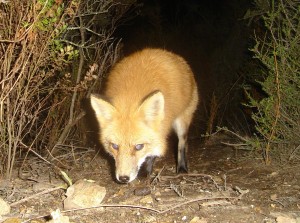Photographer and teacher, Christian Naventi, has a special talent for bringing animals in the wild closer to the children he teaches through his use of critter cameras. With photos and videos, he’s able to capture brief moments of animals in their natural state as they pass his cameras. Christian has developed a deep love for Knowland Park and has shared his talents with us to help us reveal the sometimes hidden beauty of Knowland Park. Unlike animals in captivity, wild animals are shy and reluctant to expose themselves to the danger we humans pose. Knowland Park is habitat for many species of wild animals that must share the park with us but often remain carefully hidden out of sight.
Christian has posted videos from Knowland Park on Youtube (https://www.youtube.com/channel/UCTn7IFUe8aCtPNChS-d8f1w?feature=watch). We’ve included some information below on the species that you’ll see–a small fraction in the number of species that inhabit the park. He’ll continue to add more videos as they become available. As you watch the videos, you’ll be catching brief glances of these animals–this is the way that animals behave in the wild which is why even a fleeting glimpse of them is something to treasure. Replay them and each time you’ll see something new and different about them, deepening your own powers of observation. A true conservation ethic derives from appreciating the wild–the common species as well as the rare–for their inherent value. We hope that you’ll play these videos for children who by virtue of their nature have not yet lost their empathy and connection to the natural world.
Some of these species are also featured in our slideshows on the website along with more information about their natural history and behavior.
The first three videos contain footage of Black-tailed deer (Odocoileus hemionus columbianus) moving through the oak woodland. In Black-tailed deer 2 and 1, female deer (does) approach from behind the camera and bound past it. Notice the white rump and raised white underside of the tail which act as an alarm to the individuals following the leader that danger may be near. The third deer video shows a doe making a cautious approach as she picks her way through the woodland. Notice her large ears which act as sound collectors. The chief predator of Black-tailed deer is the mountain lion which ambushes deer, often from above. Fawns are taken by coyotes and even golden eagles.
The gray fox (Urocyon cinereoargenteus) in this video is our native fox. Unlike the introduced red fox (Vulpes vulpes), the gray fox is more catlike and can climb trees. Unfortunately, since the eastern red fox was introduced into California for hunting purposes, it has competed with and driven out the native gray fox in some areas. In the next two videos, the eastern red fox scent marks an area with its chin and anal scent glands. Scent-marking is a way of establishing and communicating territory to other foxes.
These last two videos capture a coyote (Canis latrans) exploring the camera trap. Thanks to the coyote’s eyeshine, we can follow its approach to the camera (there is perhaps a second one in the background). The coyote is notorious for its intelligence and curiosity–notice how it hones in on the camera for a closer look and smell. The bright eyeshine is created by the tapetum lucidum–an area behind the retina that is lined with special cells that help gather and reflect visible light to improve an animal’s vision at night. When the coyote turns away from the camera, we can see that he has mange that has affected his coat and tail, giving them a patchy appearance.
Coyotes and foxes are mesopredators–they occupy the middle of the food chain and can be preyed upon by apex predators like mountain lions. They feed on a wide variety of prey, including small mammals and birds. They also scavenge on carrion and consume berries and other plant material. Coyotes and foxes are generalists in terms of their habitat requirements, occupying scrublands, woodlands, grasslands, deserts, and the edges and parks of urban areas.
Native Americans told many tales about the coyote as the “trickster”, but the coyote’s wiliness has not earned it any appreciation among ranchers. Coyotes have been shot, poisoned, and trapped relentlessly in an attempt to exterminate them, yet their populations remain undiminished perhaps because of their intelligence and adaptability. Their high-pitched yipping heard most often at night is the quintessential voice of the west.
Both the coyote and the fox are members of the Canidae family which includes the domestic dog, and, in fact, coyotes can interbreed with dogs. You can compare some of the physical differences between the two fox species and the coyote in these videos. Foxes are shorter, more compact, and more delicate. They possess a long thick luxuriant tail by comparison, and have shorter ears and noses. Coyotes run with their tails down while foxes carry their tails straight out behind them when running. And it appears in these videos that, while the coyote steps forward to investigate the camera and then flee, the red foxes in the videos notice the camera but are not bothered by it. The gray fox races by without stopping to investigate.
 Laura Baker is an environmental activist and former Conservation Chair of the California Native Plant Society. Growing up in Missouri, she learned that the cure for most ills rests in spending time out in nature. She wishes for every child to have the experience of wholeness that nature provides. Laura holds an M.A. in Ecology and Systematic Biology.
Laura Baker is an environmental activist and former Conservation Chair of the California Native Plant Society. Growing up in Missouri, she learned that the cure for most ills rests in spending time out in nature. She wishes for every child to have the experience of wholeness that nature provides. Laura holds an M.A. in Ecology and Systematic Biology.
Laura’s Knowlander blog is dedicated to building an online library of the natural history of Knowland Park so that the public may enjoy the park for the natural heritage treasure that it is. Knowing the land is a never ending process of inquiry open to all. We welcome your comments, contributions, and photos.

 Follow
Follow








Comments are closed.